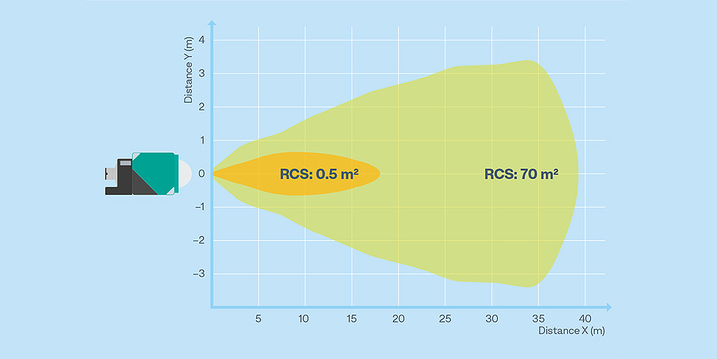Reflectivity and Typical Radar Cross-Sections
Due to their small wavelength (e.g., 12 mm at 24 GHz or 2.45 mm at 122 GHz), microwaves behave in a similar way to light, i.e., effects such as diffraction, total reflection, specular deflection, interference, and a few others might occur. Many properties of radar sensors can only be understood when these conditions are taken into account. In an application that is solved by radar sensors, it is speculated that an emitted wave is diffusely scattered by an object in such a way that at least a certain part of the wave is reflected back to the point of emission. The strength of this reflection (amplitude strength) depends to a large extent on the material and properties of the object.
The radar cross-section (RCS) is a measure of an object's ability to reflect radar signals. This value depends on various factors such as the size, shape, and material of the target object. Larger objects with a smooth surface generally have a higher radar cross-section and are therefore more easily detected by the radar.
The response curve shown here is an example of the wide range in which Pepperl+Fuchs radar sensors reliably detect a corner reflector with a radar cross section of 70 m² used as a reference. Smaller detection ranges are given by objects with a lower RCS or by using smaller corner reflectors (here 0.5 m² as an example).

The following table shows typical radar cross-section values and the resulting detection range within which a type MWC25M radar sensor can detect these objects. This radar cross-section is frequency-dependent, but this is not considered further here as the values are of general application.
Radar Target / Target Object |
Radar Cross-Section [mm²] |
MWC25M Detection Range [m] |
|---|---|---|
|
Ship (container ship, passenger ship) |
> 1000 |
> 50 |
|
Truck |
200 |
> 40 |
|
Car |
100 |
> 35 |
|
Corner reflector (metal) 10 cm |
70 |
> 25 |
|
Corner reflector (metal) 5 cm |
5 |
> 18 |
|
Tree (large) |
1 |
> 12.5 |
|
Human |
0.5 … 1 |
> 12.5 |
|
Bird |
0.01 |
- |
The properties of other possible radar targets or target objects become clearer when the dependencies of materials are considered.









 +44 161 6336431
+44 161 6336431